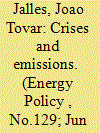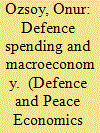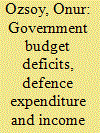| Srl | Item |
| 1 |
ID:
166576


|
|
|
|
|
| Summary/Abstract |
In this paper, we empirically assess by means of the local projection method, the impact of different types of financial crises on a variety of pollutant emissions categories for a sample of 86 countries between 1980 and 2012. We find that financial crises in general lead to a fall in CO2 and methane emissions. When hit by a debt crisis, a country experiences a rise in emissions stemming from either energy related activities or industrial processes. During periods of slack, financial crises in general had a positive impact on both methane and nitrous oxide emissions. If a financial crisis hit an economy when it was engaging in contractionary fiscal policies, this led to a negative response of CO2 and production-based emissions.
|
|
|
|
|
|
|
|
|
|
|
|
|
|
|
|
| 2 |
ID:
083234


|
|
|
|
|
| Publication |
2008.
|
| Summary/Abstract |
This study uses a six-variable vector autoregressive (VAR) model and analyses the relationship between defence spending as a percentage of GNP, government budget as a percentage of GNP, total deficit as a percentage of GNP, the GNP growth rates, inflation rates, and government budget deficit as a percentage of GNP for the case of Turkey from 1933 to 2004. The impulse response functions (IRFs) are also derived and Granger causalities among the variables estimated. The results support the short-run causality between defence spending and economic growth.
|
|
|
|
|
|
|
|
|
|
|
|
|
|
|
|
| 3 |
ID:
083227


|
|
|
|
|
| Publication |
2008.
|
| Summary/Abstract |
This paper analyzes the relationship between government budget deficits, defence expenditure and income redistribution among different social-income groups in Turkey for the period 1965-2003. The analysis was based on a five-equation vector auto regressive (VAR) model and impulse response functions (IRFs) derived from the VAR model. The study finds that the deficit as a percentage of GNP has a negative and significant impact on transfer payments as a percentage of GNP. The IRFs indicate that shocks to deficit expenditures as a percentage of GNP (DEFGNP) have statistically significant impacts on defence spending as a percentage of GNP (DSGNP), educational expenditures as a percentage of GNP (EDGNP), health expenditures as a percentage of GNP (HEGNP), and transfer payments as a percentage of GNP (TPGNP). The results derived from this study also indicate that there is a positive and significant relationship between defence spending as a percentage of GNP and deficits as a percentage of GNP. Therefore, defence spending is viewed as a tool for transferring income among different social-income groups and across generations in Turkey for the period 1965-2004. As a result of this, the government can use deficit and defence spending as one of the major instruments to transfer income among different social-income groups and across generations in Turkey.
|
|
|
|
|
|
|
|
|
|
|
|
|
|
|
|